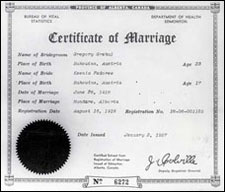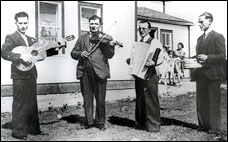|

The Pre-Wedding Phase
The Wedding Day
Inquiries [dopyty]
In 1920, it was common practice for young men to gather on Sunday evenings at
one of the prominent community houses in Swan Plain, which also served as a
store and post office.
One Sunday, two young men from several miles away happened to drop in on such a
gathering while a group of local boys played cards. They knew the local boys
generally, but were not particularly close. The store owner's daughter,
sixteen, was also present, and caught the eye of one of these distant visitors.
He spoke to her briefly, then decided to ask his friend to make more formal
inquiries as to a wedding. The friend didn't think this was a good idea, but
the prospective groom insisted. Acting formally as a sort of matchmaker
[starosta] the friend quietly wrote the girl a note to "go outside," where he
uncomfortably explained what he had been asked to do. Partly out of surprise,
the girl agreed that he could inform her parents that he requests her hand in
marriage. This procedure took place discreetly and most of the company parted
that evening without realizing what had transpired.
Engagement [zaruchyny ] and Agreement [uhovoryny]
When the local boys had gone, the two visitors asked the girl's father and
mother for her hand in marriage. The parents were somewhat taken aback by this
information, and even more amazed when they deferred the decision to their
daughter and she accepted. By the next morning, the prospective groom's mother
and the bride's parents and grandparents assembled for discussion. It was
typical to celebrate a wedding some three weeks after the engagement. There was
a concern that the Christmas Lenten season (Pylypivka) was less than two weeks
away, and there was no time to arrange a wedding this year. In this case, it
was decided that the wedding was to take place that very week. The
wreath-weaving [vinkopletennia] was to take place on Thursday and the church
marriage ceremony [vinchannia] on Friday, with the celebrations following for
several days. Because the groom's father was deceased and his family was not
wealthy, it was decided that the wedding celebrations would partially be
combined together, and would take place at her parents' house.
Arrangements
A day after the agreements had been made, the bride, her mother, and groom
travelled by horse and wagon eighteen miles to Norquay to buy things for the
wedding. Wedding rings were ordered at $ 7.00 a pair. White materials and lace
were bought for a wedding dress. The bride's mother bought cloth with which to
sew bed sheets and pillowcases for the bride's dowry. That evening the groom's
mother visited the bride's and made further arrangements.
 Licence Licence
In 1920 it was necessary to purchase a marriage licence before getting married.
The couple had difficulty in obtaining a marriage licence because the bride was
under 18, and she was not accompanied by her father, who should sign to document
his permission.
Invitations [zaprosyny]
After the date was set, the bride wrote notes to her relatives who lived far
away, inviting them to her wedding. These were delivered by the bride's distant
cousin, and were likely the first written wedding invitations in that area. She
was too nervous and excited to sew the wedding dress, or even simple
pillowcases, so her aunt stepped in to help. Taking her cousin as bridesmaid
[druzhka], the bride spent the remainder of Tuesday and Wednesday inviting
friends and relatives to the wedding. The bride's brother drove the two girls
by horse for several miles in each direction to relatives and friends. Arriving
at a farmstead, she would bow deeply to the man and to the woman of the house
and ritually recite to them, "My father invites you, my mother invites you, and
I invite you."
The groom and his best man [druzhba] travelled to their own guests on Thursday,
inviting them in the same manner. They rode in a cutter (light wagon) and
hurried their horse so that they could invite as many people as possible.
Turning at one of the farmyards, the wagon overturned and fell onto the groom's
leg. Fortunately, he was not seriously injured, though it did cause him to come
late for the blessing and caused extra anxiousness that evening.
 The
musicians The
musicians
Only one informal group of musicians played at this wedding consisting of local
men who played a violin [skrypka], hammered dulcimers [tsymbaly], and bass
fiddle [bas]. They played on Thursday night at the wreath-weaving ceremony, as
well as on Friday and Saturday.
Wedding tree [derevtse]
The bride's brother selected and cut down a two-foot spruce sapling to be used
as the derevtse. After being ceremoniously decorated with paper and other
things, it was inserted into the centre of a ceremonial loaf of bread [kolach].
Wreath-weaving [vinkopletennia]
On Thursday evening, the vinkopletennia took place in the bride's house. Many
people gathered for the wreath-weaving. The bride bowed three times to each of
the older people and once to those who were younger. Crossing the doorway,
there were benches on three walls of the room filled with relatives and
neighbours. With the help of the bridesmaid, the wedding mother started the
weaving of the wreath. She took the first four or five branches of periwinkle
and wove them together. The matchmaker spoke and invited the father of the
bride and then the mother of the bride to bless their daughter with the
periwinkle. Then the bride's relatives, brothers, sisters and everyone present
were called upon in order to bless the bride and the making of the wedding
wreath. Each person, as they blessed the bride, added a few branches of
periwinkle to the wreath making a long string of woven branches. Then the
wedding mother and other young women wove a round wreath to fit the bride's
head. Especially sorrowful songs were sung at this time.
Buying of the bride's wreath and bouquets [vyhuliannia]
When the wreath weaving was finished, the starosta called upon the groom and
his best man to buy the wreath [vinochok] and the bouquets [bukety] from the
bride. The bridesmaid had made the bouquets earlier in the day. They consisted
of a flower, periwinkle and a ribbon. When the groom and best man had them
pinned on their lapels, the ribbons hung down to their waists. The groom bought
the wreath and his bouquet from the bride. The best man in the same way, gave
money to his bridesmaid for his bouquet. The girls at this time sang joyful and
even comic songs, directed at the groom.
|




